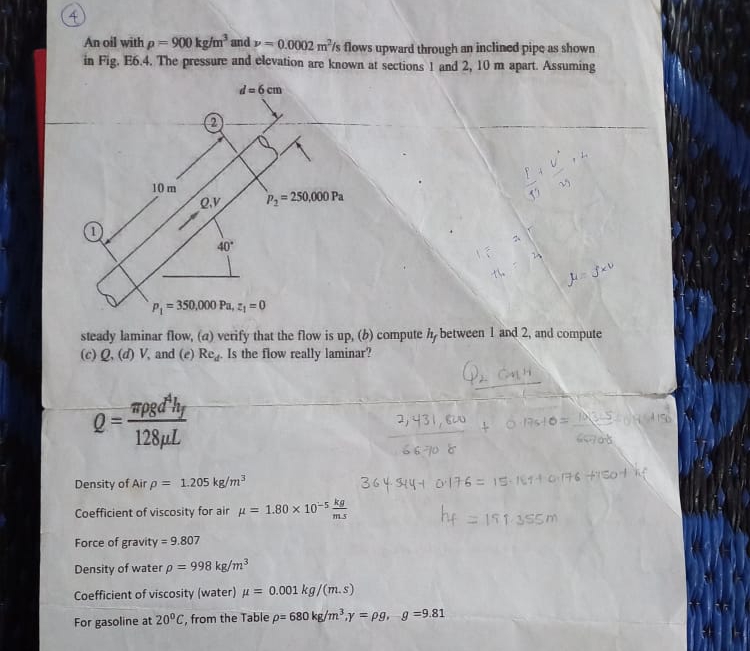An oil with p-900 kg/m' and »=0.0002 m/s flows upward through an inclined pipe as shown in Fig. E6.4. The pressure and elevation are known at sections 1 and 2, 10 m apart. Assuming d=6 cm 10 m P2= 250,000 Pa 40" th P=350,000 Pa, z = 0 steady laminar flow, (a) verify that the flow is up, (b) compute h, between I and 2, and compute (c) Q. (d) V, and (e) Re. Is the flow really laminar? mpgd'hy Q = 128µL 2,431, B0 66 70 &
An oil with p-900 kg/m' and »=0.0002 m/s flows upward through an inclined pipe as shown in Fig. E6.4. The pressure and elevation are known at sections 1 and 2, 10 m apart. Assuming d=6 cm 10 m P2= 250,000 Pa 40" th P=350,000 Pa, z = 0 steady laminar flow, (a) verify that the flow is up, (b) compute h, between I and 2, and compute (c) Q. (d) V, and (e) Re. Is the flow really laminar? mpgd'hy Q = 128µL 2,431, B0 66 70 &
Elements Of Electromagnetics
7th Edition
ISBN:9780190698614
Author:Sadiku, Matthew N. O.
Publisher:Sadiku, Matthew N. O.
ChapterMA: Math Assessment
Section: Chapter Questions
Problem 1.1MA
Related questions
Question

Transcribed Image Text:An oil with p= 900 kg/m' and v= 0.0002 m/s flows upward through an inclined pipe as shown
in Fig. E6.4. The pressure and elevation are known at sections I and 2, 10 m apart. Assuming
d= 6 cm
10 m
P2= 250,000 Pa
40
P= 350,000 Pa, z, =0
steady laminar flow, (a) verify that the flow is up, (b) compute h, between 1 and 2, and compute
(c) Q. (d) V, and (e) Re. Is the flow really laminar?
apgdhy
Q =
2,431, 60
128µL
66 70 &
Density of Air p = 1.205 kg/m
364 S44+ o176 = 15-1614 o76 +5o1
Coefficient of viscosity for air u= 1.80 x 10-5
he = 151 355m
m.s
Force of gravity = 9.807
Density of water p =
998 kg/m3
Coefficient of viscosity (water) u = 0.001 kg/(m.s)
For gasoline at 20°C, from the Table p= 680 kg/m,y = pg, g=9.81
Expert Solution
This question has been solved!
Explore an expertly crafted, step-by-step solution for a thorough understanding of key concepts.
Step by step
Solved in 3 steps

Knowledge Booster
Learn more about
Need a deep-dive on the concept behind this application? Look no further. Learn more about this topic, mechanical-engineering and related others by exploring similar questions and additional content below.Recommended textbooks for you

Elements Of Electromagnetics
Mechanical Engineering
ISBN:
9780190698614
Author:
Sadiku, Matthew N. O.
Publisher:
Oxford University Press

Mechanics of Materials (10th Edition)
Mechanical Engineering
ISBN:
9780134319650
Author:
Russell C. Hibbeler
Publisher:
PEARSON

Thermodynamics: An Engineering Approach
Mechanical Engineering
ISBN:
9781259822674
Author:
Yunus A. Cengel Dr., Michael A. Boles
Publisher:
McGraw-Hill Education

Elements Of Electromagnetics
Mechanical Engineering
ISBN:
9780190698614
Author:
Sadiku, Matthew N. O.
Publisher:
Oxford University Press

Mechanics of Materials (10th Edition)
Mechanical Engineering
ISBN:
9780134319650
Author:
Russell C. Hibbeler
Publisher:
PEARSON

Thermodynamics: An Engineering Approach
Mechanical Engineering
ISBN:
9781259822674
Author:
Yunus A. Cengel Dr., Michael A. Boles
Publisher:
McGraw-Hill Education

Control Systems Engineering
Mechanical Engineering
ISBN:
9781118170519
Author:
Norman S. Nise
Publisher:
WILEY

Mechanics of Materials (MindTap Course List)
Mechanical Engineering
ISBN:
9781337093347
Author:
Barry J. Goodno, James M. Gere
Publisher:
Cengage Learning

Engineering Mechanics: Statics
Mechanical Engineering
ISBN:
9781118807330
Author:
James L. Meriam, L. G. Kraige, J. N. Bolton
Publisher:
WILEY